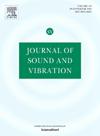Thermomechanical transient dynamics of radial rotor–stator contact
IF 4.9
2区 工程技术
Q1 ACOUSTICS
引用次数: 0
Abstract
The present paper discusses the numerical investigation of structural interactions initiated radially between a turbine shaft and an annular stator. The rotorshaft is modeled under the rigid bodies assumption while the stator is discretized in space with curved Bernoulli beam elements. The turbomachine is assumed to be driven by two torques: the first one is prescribed from aerodynamics while the second one is induced by sliding friction from Coulomb’s model and must be assessed. The study is motivated by the need to predict the dynamic behavior of the rotorshaft in the presence of radial contact between the labyrinth and the annular stator. If rotordynamics accounting for unilateral and frictional contact is widely developed in literature, the combination with an unknown rotational velocity and thermomechanical coupling must still be investigated. Indeed, heat generation and subsequent thermal expansion is expected to modify the contact interface and the dynamic response. The system is solved in the time domain and contact treatment is achieved though a modified version of the Carpenter algorithm. The identification of the conditions affecting the rotational speed is achieved through a sensitivity analysis on the stator properties, friction coefficient and coefficient of thermal expansion. Results confirm that the higher the friction coefficient and stator stiffness are, the lower the maximum rotational velocity value is. It is also shown that high temperatures are located in specific regions on the stator and that the temperature peaks are amplified with thermal expansion.
径向转子-定子接触的热力瞬态动力学
本文讨论了涡轮轴与环形定子径向相互作用的数值研究。转子轴采用刚体模型,定子采用弯曲伯努利梁单元进行空间离散。涡轮发动机被两个力矩驱动:第一个力矩是由空气动力学规定的,第二个力矩是由库仑模型的滑动摩擦引起的,必须进行评估。该研究的动机是需要预测在迷宫和环形定子之间存在径向接触时转子轴的动态行为。如果单侧接触和摩擦接触的转子动力学在文献中得到了广泛的发展,那么与未知转速和热机械耦合的结合仍然必须进行研究。实际上,热量的产生和随后的热膨胀预计会改变接触界面和动态响应。对系统进行时域求解,并通过改进的卡彭特算法实现接触处理。通过对定子特性、摩擦系数和热膨胀系数的灵敏度分析,确定了影响转速的条件。结果表明,摩擦系数和定子刚度越大,最大转速值越小。结果还表明,定子上的高温位于特定区域,温度峰值随着热膨胀而放大。
本文章由计算机程序翻译,如有差异,请以英文原文为准。
求助全文
约1分钟内获得全文
求助全文
来源期刊

Journal of Sound and Vibration
工程技术-工程:机械
CiteScore
9.10
自引率
10.60%
发文量
551
审稿时长
69 days
期刊介绍:
The Journal of Sound and Vibration (JSV) is an independent journal devoted to the prompt publication of original papers, both theoretical and experimental, that provide new information on any aspect of sound or vibration. There is an emphasis on fundamental work that has potential for practical application.
JSV was founded and operates on the premise that the subject of sound and vibration requires a journal that publishes papers of a high technical standard across the various subdisciplines, thus facilitating awareness of techniques and discoveries in one area that may be applicable in others.
 求助内容:
求助内容: 应助结果提醒方式:
应助结果提醒方式:


